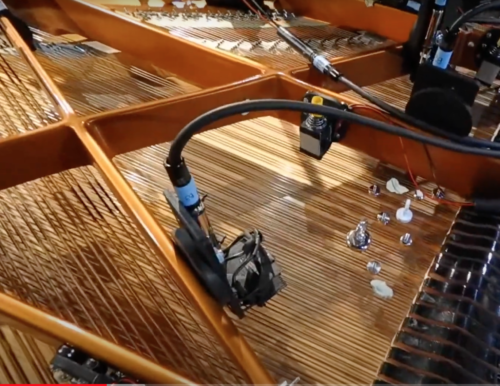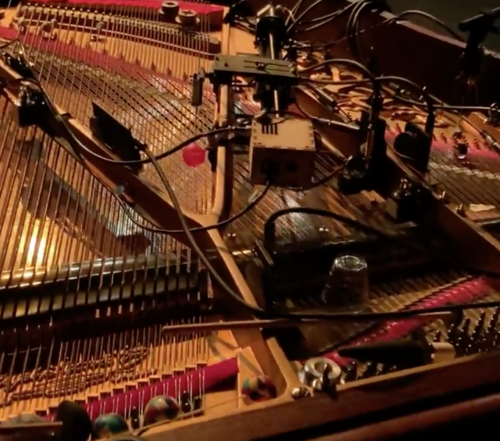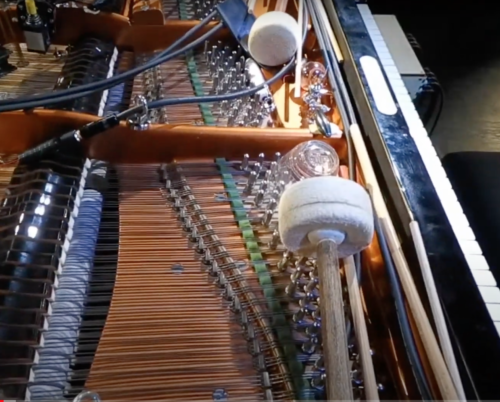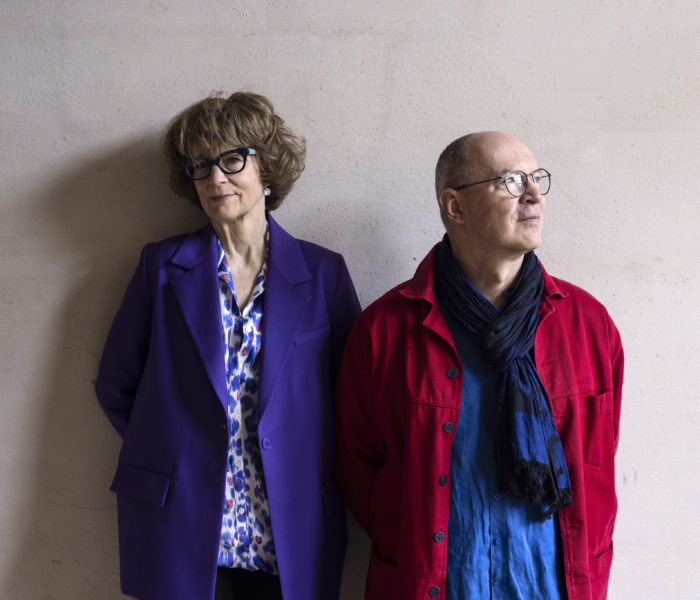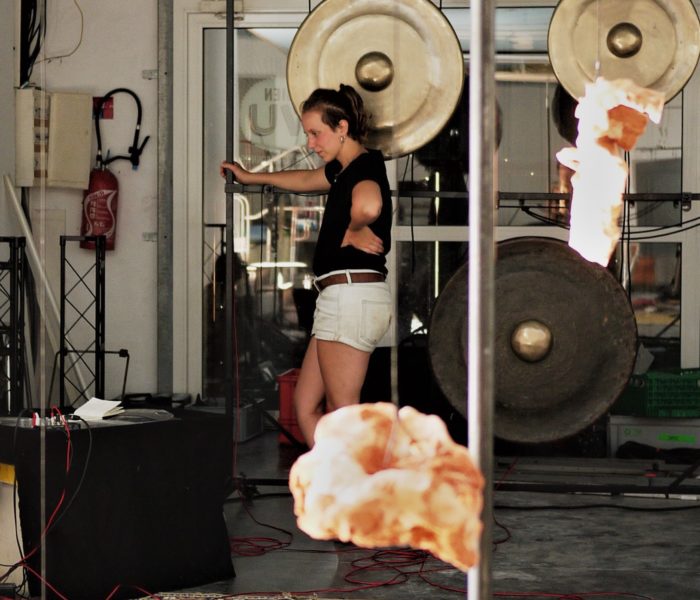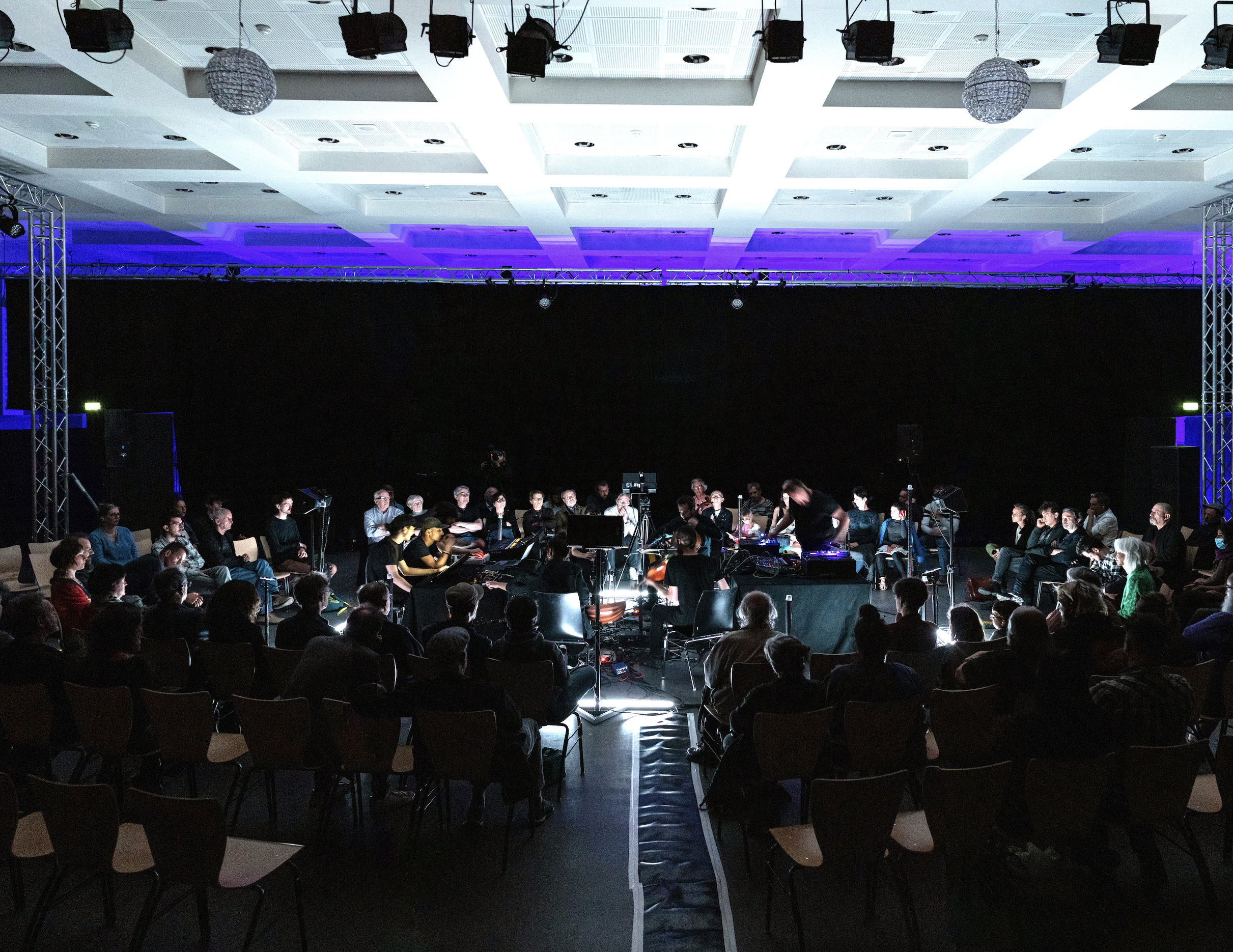Toujours en quête de nouveaux projets expérimentaux pour exprimer ses talents d’instrumentiste tout en interrogeant sa pratique, Claudine Simon part cette fois à la rencontre de son propre piano, qu’elle dissèque littéralement et enrichit de multiples machines, tout en se transformant elle-même en interprète augmentée. Histoire d’hybridation mécanique.
Tu te présentes comme « pianiste, interprète, improvisatrice, performeuse ». Tu n’ajoutes pas « compositrice » à cette – déjà – belle liste, alors que tu signes la musique de plusieurs de tes spectacles. Pourquoi ? Vois-tu une séparation entre le monde de la composition et celui de la performance ?
Effectivement je ne suis pas à l’aise avec l’étiquette de « compositrice », qui ne me correspond pas dans l’acception de ce mot tel qu’il a été utilisé jusqu’au XXe siècle. Je n’ai pas encore vraiment trouvé le bon terme pour qualifier mon travail, je dirais « musicienne polysémique ». Certes, je suis pianiste, je fais bien de la création sonore, mais ce n’est pas dans le cadre d’une musique reproductible à l’identique, qui peut se fixer sur une partition.
Dans mes projets, la musique est libre, elle se bâtit dans un geste improvisé, elle sonnera d’une certaine façon qui dépendra du contexte dans lequel je me trouve, elle va en révéler les contours dans une espèce de “sonore vibratile” qui se construit avec les musiciens.
Ça ne veut pas dire que je fais ce que je veux ou n’importe quoi : il y a des contraintes de jeu qui me font évoluer dans une certaine direction, une sorte de solfège bien complexe. Après, dans un projet scénique, il y a aussi tout un bâti dramaturgique, dans lequel la musique s’inscrit en se plaçant à certains endroits.
Finalement je joue avec de l’énergie sonore qui évolue et se façonne dans l’immédiateté et avec les personnes présentes, c’est une façon pour moi d’épouser le flux vibratoire et temporel, de m’y fondre souplement .
Qu’est-ce qui t’a poussé très tôt à emprunter les chemins sinueux de la musique de création, dès ta sortie du conservatoire ? Pourquoi ne pas avoir été plus « simplement » – si j’ose dire – concertiste, interprète d’un répertoire ? Qu’est-ce qui t’a attiré dans ces voies plus aventureuses ?
Le piano m’habite depuis l’enfance et il n’a cessé de me travailler. Et puis, à la fin de mes études de piano au CNSMD de Paris, j’ai ressenti une sorte d’asphyxie, de trop plein, vis-à-vis du répertoire soliste, de ma fonction d’exécutante. C’est finalement face à tout un milieu, à une façon de penser, que j’ai réagi.
Je trouve qu’il y a une faille narcissique chez le musicien, sans doute liée à son éducation musicale. Il y a une réflexivité qui est difficile, presque un empêchement à penser. J’ai eu un mal fou à me décoller d’une performance pratique, à passer d’une forme à exécuter vers une forme à réfléchir. Mais cette bascule m’a été nécessaire, car je n’arrivais plus à ressentir la musique que je défendais sur scène. J’ai eu besoin de déconstruire ce rapport pour me le réapproprier. La musique de création a été un moyen de sortir de cette impasse : travailler avec des compositeurs, comme Samuel Sighicelli, qui écrit du quasi « sur mesure » pour ses interprètes ; aller vers le répertoire de théâtre musical ; et surtout vers l’improvisation.
Alain Savouret (professeur d’improvisation générative au CNSMD de Paris) m’a beaucoup marqué. Il a ouvert mes oreilles au domaine du « sonore », il a fissuré mes croyances de musicienne classique. Ceci étant, j’ai aujourd’hui un immense plaisir à être interprète, à travailler auprès de compositeurs·trices, mais aussi à jouer le répertoire. Je n’ai pas vraiment de barrières esthétiques, mais j’ai des limites de temps.
Parmi tes multiples facettes, il y a également celle, pas des moindres, de conceptrice de spectacle. Souvent, d’ailleurs, tes spectacles prennent une tournure interdisciplinaire, avec d’autres musiciens, mais aussi avec des chorégraphes, des danseurs, des metteurs-en-scène, des vidéastes. Comment as-tu appris dans ce domaine, d’abord en ce qui concerne la conception et l’organisation de spectacle ?
J’ai un goût pour les écritures aux frontières de la musique, de la danse et du théâtre, parfois avec l’image aussi. J’aime nourrir une porosité entre ces disciplines, trouver des équivalences, m’ouvrir à d’autres territoires artistiques. Il y a beaucoup à partager avec un danseur par exemple : le rapport au corps, à l’espace, au geste, au temps. Ainsi, travailler avec un danseur entraîne forcément des modifications de mes façons de faire. Ça m’oblige à assimiler les différences de pratiques, de perceptions, de sensations. Ces expériences avec la danse m’ont permis un élargissement artistique, elles ont bousculé mes repères. Se confronter à cela, c’est aussi se rendre tolérant à la différence de l’autre et en saisir la richesse. Je vais de plus en plus vers une hybridation des pratiques artistiques, non pas dans le but de quitter le territoire musical, mais plutôt de le rafraîchir.
La présence d’une sœur danseuse et chorégraphe, Pauline Simon, avec qui tu as travaillé sur plusieurs spectacles (Au fil de Petrouchka en 2010, SOLI.DES en 2017 et actuellement ton Pianomachine), a-t-elle joué dans cette ouverture ?
J’ai une relation forte avec ma sœur, une fascination aussi. Son enfance a été bercée par les morceaux que je répétais, elle est entrée dans la musique sous l’angle le plus laborieux, le plus répétitif qui soit ! C’est par elle bien sûr que j’ai découvert l’univers de la danse contemporaine. Elle me voit évoluer aujourd’hui, notre sororité évolue aussi. C’est précieux de l’avoir près de moi sur des projets de création, ça a vraiment du sens.
Cette ouverture est-elle encore l’objet de ce dernier projet, Pianomachine : comme un piano augmenté, et également une pianiste augmentée ?
Mais exactement !
On peut voir quelque chose d’inquiétant dans tous ces mécanismes robotisés, ou de fascinant, l’un n’empêchant pas l’autre. Tu parles d’une personnalisation, voire d’une sensualisation de la machine. Quel est ton rapport à la technologie ?
La technologie m’intéresse dans la mesure où elle me donne la possibilité de travailler la perception, les différents aspects du sensible. En greffant des machines sur le piano, je me rapproche de la notion de « machine désirante » envisagée aussi comme un « corps sans organe » propre aux réflexions de Deleuze et d’Artaud. Ici, ces forces contribuent à défaire la hiérarchie des organes originels de l’instrument. Les zones habituelles de l’écoute sont ainsi déplacées, voire désinvesties. Un espace s’ouvre, fait de sensualité en tant que puissance libérée, qui offre la possibilité de nouveaux mécanismes, d’agencements, de circulation.
Dans nombre de tes spectacles, on te voit sous ton piano et dedans, t’appropriant sa géographie en explorant et en jouant avec tous ses recoins. C’est aussi le cas sur le petit film que tu as réalisé durant le premier confinement (Confinement / Crisis), où on se demande si tu es en lutte contre ton propre instrument ou si tu lui manifestes ton amour, condamnée à rester coincée avec lui.
Ce nouveau projet, Pianomachine, se situe également entre contrainte et libération. On a l’impression qu’il est tout entier adressé à ton instrument, comme un jalon, une étape importante de votre rapport. Est-ce le cas? Quelle est la nature de ce rapport que tu noues avec le piano ?
C’est exactement ça, je cherche à interroger ce rapport à mon instrument, avec l’idée de sortir du schéma classique, d’une situation parfois très figée du musicien asservi à son outil d’expression. Je ressens aussi le besoin de déconstruire les représentations et les idéologies, culturelles ou autres, qui lui sont associées.
Finalement, c’est le sujet sur lequel je reviens toujours : parler du désir (de cet objet du désir), avec tout ce que cela comprend comme fascination, enjeu de domination de l’instrument, d’une partition ; et cet instrument qui résiste parfois, en plus de cette lutte intérieure permanente.
Je suis vraiment fascinée par cette machinerie, par cette énormité, ce rapport de force complètement déséquilibré avec le musicien, les tonnes de tension à l’intérieur, la puissance symbolique aussi, qui va du phallique au rassurant. Ma façon à moi d’interroger ce rapport, c’est de détourner, déséquilibrer, faire trembler toute cette histoire en vue de tout réinterroger.
Pourquoi la musique, c’est comme ça ? Qu’en est-il du rapport à l’instrument, de ce que l’on crée comme automatismes, autant dans la gestuelle pianistique que dans la pensée, consciente ou non ? Etc.
Dans la version scénique Pianomachine, les textes parlent exactement de ça, des forces primaires (dixit Freud) qui travaillent ce rapport, mais à la différence que le piano s’exprime ici verbalement (via un haut-parleur placé à l’intérieur), on lui donne la parole ! Il y a notamment une scène de crise, où les deux « sujets » se balancent des insultes, une violence verbale qui précède un corps à corps physique. Tout cela m’oblige à me risquer beaucoup.
Avec la scénographie de Pianomachine, le piano est mis à nu, comme disséqué, ses entrailles livrées aux yeux du public. C’est le cas dans la version concert Labo pianomachine, mais plus encore dans la version scénique. Il a perdu toute pudeur. C’est quelque chose qu’on observait également sur le spectacle d’Heiner Goebbels, Stifters Dinge, où les pianos étaient également joués par des dispositifs mécaniques. Le connais-tu ?
Oui, la pièce de Goebbels est magnifique. Je n’ai pas eu la chance de la voir en live, mais l’univers scénographique avec les pianos joués par des machines est bluffant.
L’idée de la dissection est d’abord en lien avec l’idée de proposer une sorte de visite guidée sonore interne du piano. Mais j’avais aussi envie que le public voit ses entrailles, ses viscères, profite de toute la beauté anatomique de l’instrument. Et puis il y a tout le jeu des machines qui agissent et que je montre dans la version scénique grâce à des miroirs qui viennent zoomer et même diffracter cette scène, une façon pour moi de créer une mise en abyme, un autre point de vue. Dans la version concert, le public autour du piano a également la possibilité de voir un peu l’intérieur. J’aimerais un jour prolonger ce travail scénographique et même plastique du piano dans une prochaine étape de mon travail.
Comment ces dispositifs ont-ils été conçus ? D’où est venue l’idée ? Comment s’est agencée la phase des prototypes avec les étudiant·e·s ingénieur·e·s de l’Insa de Lyon ? Comment as-tu rencontré ensuite Sonopopée (et qui sont-ils) ?
Après avoir mené tout un travail de recherche de timbres autour du piano préparé, j’ai voulu le prolonger, l’approfondir avec un instrument que j’ai finalement imaginé sur mesure. J’ai mené une première phase de recherche de six mois avec une trentaine d’étudiants de l’Insa de Lyon, deux professeurs et la compositrice Raphaèle Biston. Les étudiants ont construit des prototypes qui m’ont permis de faire les premières expérimentations avec les machines dans le piano, que j’ai pu jouer avec le compositeur Marco Suarez.
Par la suite, j’ai rencontré Christian Sebille, compositeur et directeur du GMEM à Marseille, qui travaillait sur une installation sonore avec un orchestre de verre joué par des automates, Paysage de propagations. Nos deux projets utilisant la même technologie, il a eu envie de faire avancer le mien à côté du sien, et de le produire. Il a considérablement aidé ma recherche. Il m’a mis en relation avec le collectif Sonopopée composé de Vivien Trelcat, Max Lance et Nicolas Canot. Il s’agit d’un collectif spécialisé dans les lutheries informatiques, électroniques et hybrides, qui a totalement repensé mon dispositif. Finalement, toutes les machines du piano ont été refaites.
Raconte-nous comment ça se passe. Tu travailles avec un performeur machines sur ordinateur, Vivien Trelcat : quel est son rôle ? Est-il aussi musicien à part entière ? Y a-t-il des automations ? De l’aléatoire ?
L’apport de Vivien est très important. Il a développé tout l’instrument-logiciel, il actionne les machines, il interagit avec moi en tant que musicien improvisateur. Nous formons une sorte de quatre mains éclaté. Il transforme le son en temps réel et le diffuse en multiphonie. On développe ensemble toute une grammaire musicale, une recherche de timbres, des espaces de jeu et d’écoute entre ce qui est improvisé et le jeu avec l’aléatoire, les algorithmes… On travaille aussi sur les ambiguïtés, les faux-semblants entre sons acoustiques et sons électroniques, si bien qu’on ne sait pas toujours qui joue !
Pianomachine — Claudine Simon from GMEM on Vimeo.
Comment avez-vous effectué les réglages et la narratologie du spectacle dans sa version scénique ?
L’idée était de préparer en amont toutes les matières de textes écrit par le philosophe Franck Lemonde, d’intention, de grammaire sonore, d’agencement du corps pour les confronter à une sorte de vérité de plateau. Je ne voulais pas figer les scènes imaginées, je voulais les éprouver au plateau, quitte à remettre en morceaux certaines d’entre elles. C’était l’objectif des deux dernières semaines de résidence à la Muse en Circuit en février et au GMEM en mars. La création a eu lieu le 10 mars au Théâtre d’Orléans et sera reprise au festival Musique Action le 30 septembre prochain.
Propos recueillis par Guillaume Kosmicki



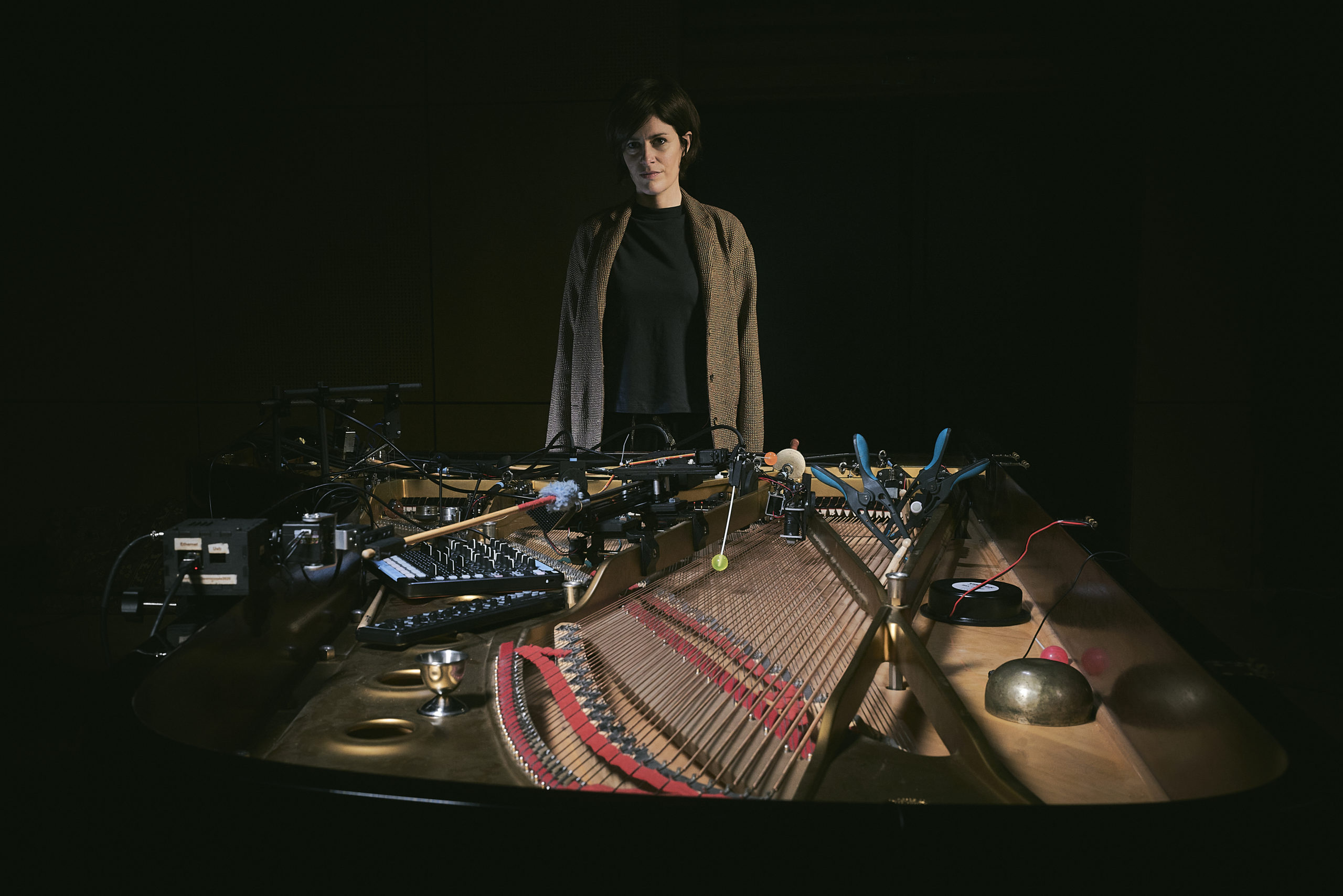)
